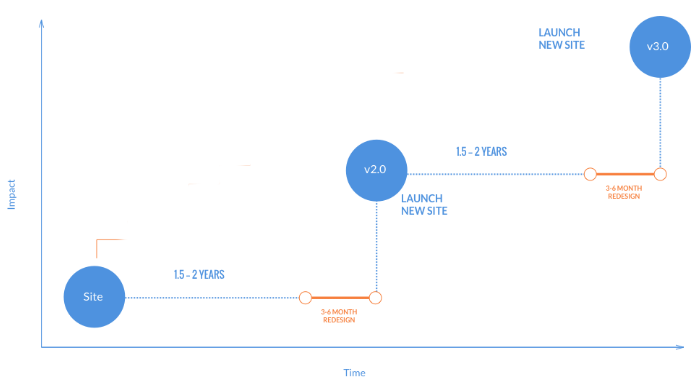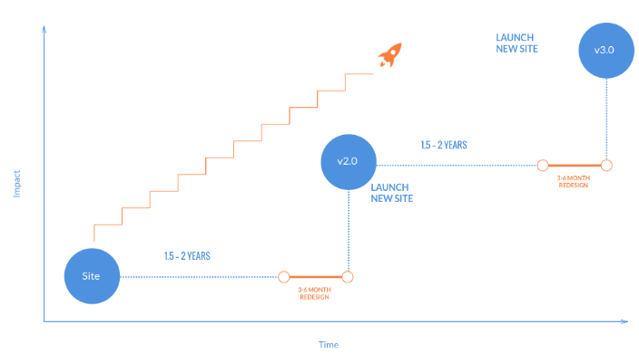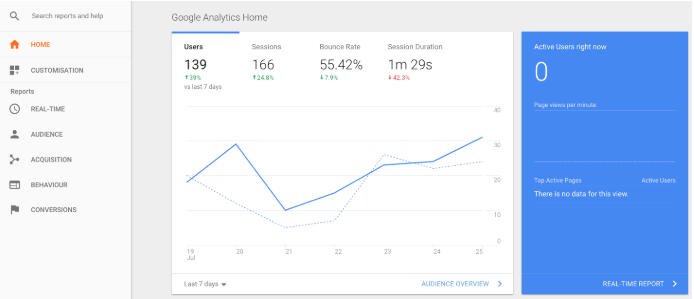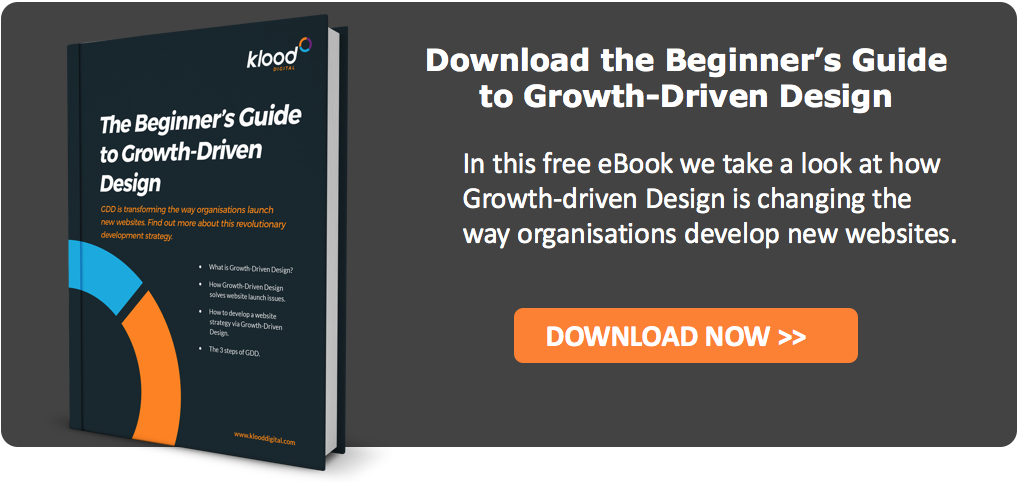Get weekly
HubSpot updates
Developing a website, whether you’re starting from scratch or updating an existing site, is no easy feat. It requires substantial man hours and budget, so it’s fair to say it can come as a relief once the finished product is finally live.
Except this is where so many organisations — I dare say, the vast majority of organisations — go wrong.
You should never consider your website as being ‘finished’. In 2018, it’s your website that is your hardest working sales asset, working 24/7 to educate your target audience about how you can help to solve their problems. You wouldn’t hire a sales team and stop trying to train and improve them after their initial induction, would you?
So, what am I suggesting? That you launch a brand new website every year? Every six months?
On the contrary, by adopting the principles of Growth-driven Design (GDD) you can ensure you never have to launch another website ever again.
That’s a pretty bold statement, so I better start justifying it…
Already curious about GDD? Download our FREE Beginner’s Guide to Growth-driven Design.
What is Growth-driven Design?
We’ve gone into detail on how GDD works previously in blogs like this one, as well as the eBook linked to above, but I’ll give a brief overview again here.
There are three parts to the GDD process:
- Strategy
- The Launchpad
- Continuous Improvement
Strategy
The first step is to devise your strategy — thoroughly.
The aim of this stage is to create a comprehensive and empathetic insight into your target audience’s world. What problems do they experience on a day-to-day basis and how can you help solve them? This will require a comprehensive understanding of your buyer personas.
Beyond that, you need to understand your own goals as an organisation. Without them, how can you measure success? Start with your sales targets and reverse-engineer them to discover how many prospects, leads, and website visitors you’ll need.
The Launchpad
The traditional web design process was an arduous one. The design and planning stage would take a long time, but then development would take even longer. Not only would you need to build every feature you’ve identified as necessary, there’d be endless tinkering to perfect the finished product. After all, this is going to be how your website looks for a couple of years, so better make sure it’s perfect, right?
In GDD the Launchpad website is just the start. It should include all of the features deemed essential to your website, but nothing more. Adopt the 80/20 rule: include 20% of the functionality that will deliver 80% of the results.
You should be aiming to get the Launchpad completed within 60-90 days of the end of the strategy phase — a far quicker turnaround than with traditional web design.
Continuous Improvement
The biggest problem with traditional web design is that it requires a huge amount of investment based on opinions, not data. You can’t know how well something will perform until it’s launched and people actually start using it.
However, by saving all that time and money on the initial Launchpad, you will have the budget to optimise and improve in the coming months — except this time it will be based on real user data, not gut-feel.
And this process never stops
Finally, we come back around to the point I made in the title of this blog post.
The traditional web design process would typically follow this format:

As you can see, the only time you actually develop and improve your website is maybe every 1.5 or 2 years, in that three to six month design period. Why do organisations wait for these intervals? Because the process of designing and developing a brand new website can be such a painful (and expensive) experience!
A Launchpad website spreads the cost and, as a result, the risk. The Launchpad is just the base from which you’re going to start from, meaning it is much quicker — and cheaper — to develop. Rather than the inefficient and costly process above, the Growth-driven Design process instead looks like this:
 Instead of major changes only launched every couple of years, GDD offers many smaller improvements based on real user data that can be implemented rapidly.
Instead of major changes only launched every couple of years, GDD offers many smaller improvements based on real user data that can be implemented rapidly.
What do you need for effective Growth-driven Design?
In theory, any organisation can practice the principles of GDD, but there are a few things you’ll need in place to do it properly.
An intuitive content management system
There are many different platforms on which to build a website, but if your GDD is going to be successful, you’ll want to choose one that makes it easy to make regular website changes. Not just easy for your web development team to work with, but one your marketing team can work with too.
Inbound marketing is at the heart of GDD, and you’ll be making website decisions on key marketing metrics. You don’t want to flood your dev team with ticket after ticket requesting relatively minor changes, as this will lead to bottlenecks in the process.
Analytics software
GDD is about making decisions based on data, not gut-feel or the opinion of the highest paid person in the room.
With this in mind, you’re going to need to take advantage of analytics software to harvest that data.

Google Analytics is free to use, and offers a huge amount of data on how your users are interacting with the website: total sessions on specific web pages, whether or not users are exiting the site on those pages, the source of those sessions (for example, organic or social traffic), the countries those users are coming from, and much more besides.
Check out Moz’s excellent post, The Absolute Beginner’s Guide to Google Analytics, for a crash course on how to use this tool.
Conversion Rate Optimisation
Google Analytics can tell you how users are interacting with your website, but they won’t tell you why.
Conversion rate optimisation (CRO) software can help to understand why users are leaving on certain webpages, which calls-to-action (CTA) they are clicking on most and whether or not they are even scrolling far enough to see your most valuable CTAs. You can even set up recordings and actually watch a user’s session on your site! Invaluable information to a GDD team.
Closely aligned marketing and development teams
Earlier I mentioned bottlenecks arising if you rely on your web development team to action every single change.
By choosing the right CMS you can empower your marketing team to make website changes themselves, but they’ll still need to rely on the development team for more complex tasks.
To ensure this doesn’t lead to delays, both teams need to be closely aligned. This means communicating regularly (think daily or weekly stand-ups) as well as a clear SLA on when tasks will be completed. Marketers and developers can often be siloed, but this cannot be allowed to happen if you want to have a successful GDD process.
Interested in finding out more about how Growth-driven Design can revolutionise your business? Click below and download our free beginner’s guide to this innovative methodology.


